Birds are an integral part of the Seaside landscape. Whether hiking along the beach or relaxing in a park, you’ll likely spot various bird species.
From colorful songbirds to majestic raptors, birds of all shapes and sizes can be seen in the skies over Seaside.
With its diverse habitats and abundant food sources, Seaside is a haven for both bird watchers and nature enthusiasts.
From the iconic seagulls that wheel in the salty air to the vibrant warblers that flit through the forests, there’s something for everyone to enjoy.
Whether you’re an avid birder or just curious about the diverse avian population of Seaside, there’s something for you to discover.
1. Sanderling

The sanderling is a small wading bird found in coastal locations worldwide. It is from the Scolopacidae family, and its genus name is Calidris.
The bird’s name comes from Old English and means “sand-plowman,” referring to its habit of running along the beach to plow the sand for food.
The specific name, alba, is Latin for “white,” referring to the white underside of the bird. Aristotle was among the first to mention the sanderling in his writings, referring to them as “grey-colored waterside birds.”
This likely refers to the greyish-brown upperparts and white underside of the bird. The sanderling is a small bird measuring about 6-7 inches long. It has a short bill, long legs, and a distinctive white stripe on its forehead.
The bird runs up and down the shoreline, searching for small invertebrates such as insects, larvae, and mollusks in the sand. The sanderling also feeds on small fish and crustaceans.
The sanderling is a migratory bird, traveling between its breeding grounds in the Arctic and its wintering grounds in southern parts of the world. During the winter, it can be seen in large flocks on beaches along the coasts of Europe, Africa, and the Americas.
The sanderling is an important species to many ecosystems, helping to keep beaches clean by foraging for food and keeping the sand aerated. It is also an important food source for predators like foxes, hawks, and owls.
| Kingdom | Animalia |
| Phylum | Chordata |
| Class | Aves |
| Order | Charadriiformes |
| Family | Scolopacidae |
| Genus | Calidris |
| Species | C. alba |
2. Seagull
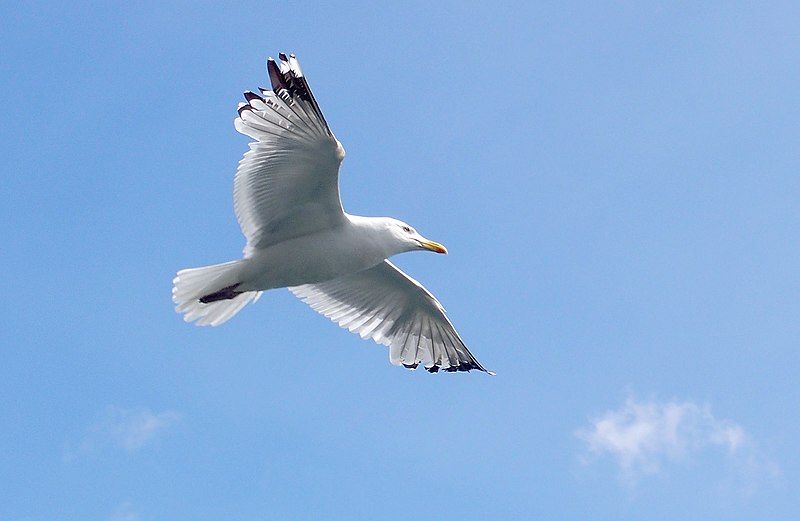
Gulls, also known as seagulls, are a type of seabird that belong to the family Laridae of the suborder Lari. They are closely related to terns and skimmers and more distantly related to auks and waders.
Gulls live and breed near oceans, seas, and other large bodies of water. They can be found worldwide in various climates, although they are most abundant in temperate climates.
Gulls are highly adaptable and can be seen in various habitats, including coastal areas, marshes, and even urban areas. Gulls feed on various foods, such as fish, crustaceans, insects, garbage, and other human-related items.
Their diet is highly varied, and they can use various food sources. Gulls are highly social and can often be found in large flocks, which can help protect them from predators.
Gulls are highly intelligent birds and have been known to use tools to obtain food. All in all, gulls are a highly adaptable, intelligent, and social seabird species.
| Kingdom | Animalia |
| Phylum | Chordata |
| Class | Aves |
| Order | Charadriiformes |
| Family | Laridae |
3. Willet
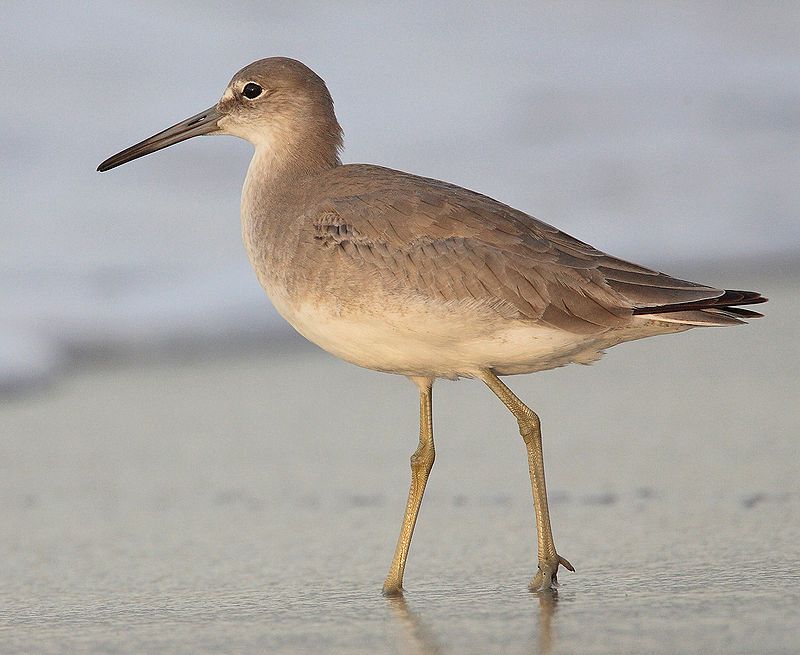
The willet is a species of shorebird found within the family Scolopacidae, a group consisting of sandpipers, curlews, and godwits.
This species is considered to be a relatively large and robust sandpiper and is the largest of a group of species known as “shanks” in the genus Tringa. Willets have long, greyish-brown wings and a white belly.
Its back is streaked with black and white stripes, and its head is grey with a white eye stripe. Its bill is long and black, and its legs are yellowish-green.
Willets can be found in flocks along coastal areas, often feeding in shallow waters on small crustaceans, mollusks, and aquatic insects. They also feed on insects, grasses, and small fish.
They can be seen in pairs during the breeding season, defending their nesting territories.
| Kingdom | Animalia |
| Phylum | Chordata |
| Class | Aves |
| Order | Charadriiformes |
| Family | Scolopacidae |
| Genus | Tringa |
| Species | T. semipalmata |
4. Oystercatcher
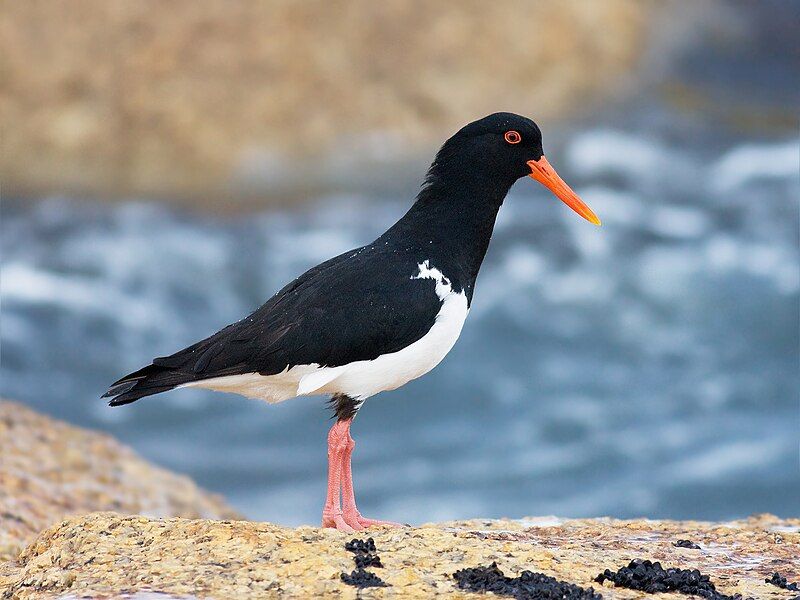
Oystercatchers are a type of wading bird found on coasts worldwide. They are part of the family Haematopodidae, which consists of only one genus called Haematopus.
The only exceptions are polar regions and some parts of Africa and Southeast Asia, as oystercatchers are not found in these places. Oystercatchers are found in various habitats, including sandy beaches, rocky shores, estuaries, mudflats, and coastal lagoons.
They feed mainly on mollusks such as oysters, mussels, and clams, but they also eat other invertebrates, such as insects and worms. They have a strong, pointed bill with a black tip that is used to pry open the shells of their prey.
Oystercatchers are highly social birds, often seen in large flocks. They are vocal birds and use a wide range of calls to communicate with each other. Oystercatchers are an important part of the coastal ecosystem, as they help keep the mollusk population in check.
| Kingdom | Animalia |
| Phylum | Chordata |
| Class | Aves |
| Order | Charadriiformes |
| Family | Haematopodidae |
| Genus | Haematopus |
5. Sandpiper
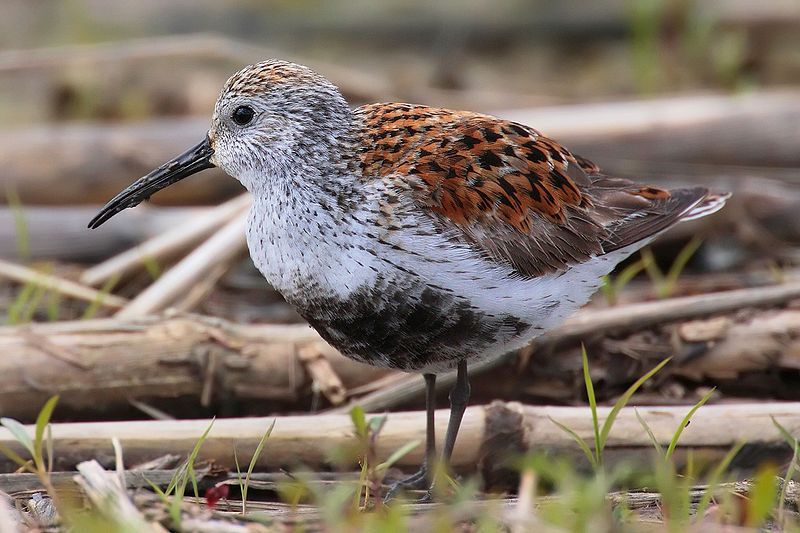
Sandpipers are a large family of waders, scientifically known as Scolopacidae. They are a diverse group of birds, with many species classified as sandpipers and those referred to as curlews and snipes.
Most sandpiper species have adapted to feed on small invertebrates, such as worms, mollusks, and crustaceans, which they pick out from mud or soil. Sandpipers have long, slender bills that help them probe in the mud for these invertebrates.
Their bodies are well adapted for wading in shallow water, as their long legs and webbed feet allow them to move quickly and efficiently through the water. Sandpipers are highly migratory, flying great distances to reach their wintering grounds.
They also have a unique courtship display, involving the male performing intricate aerial maneuvers to attract a mate.
| Kingdom | Animalia |
| Phylum | Chordata |
| Class | Aves |
| Order | Charadriiformes |
| Family | Scolopacidae |
6. Killdeer
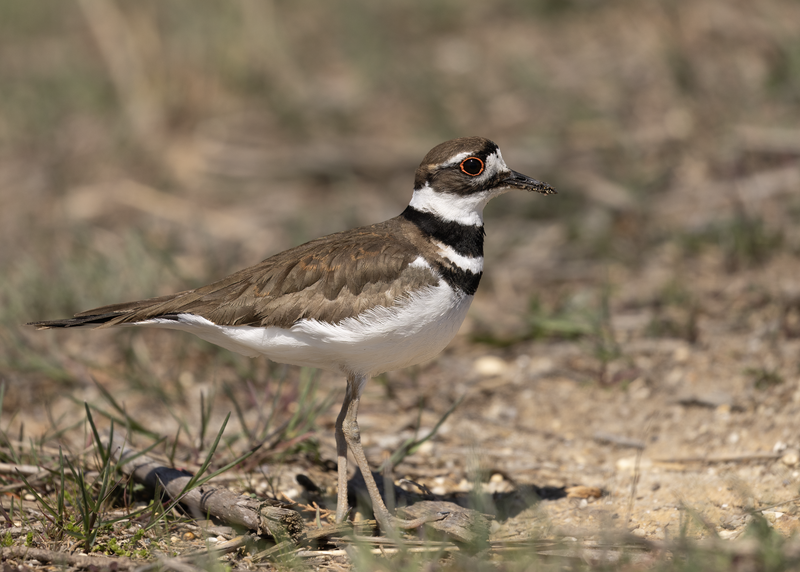
The Killdeer is a type of large plover found in the Americas. It is known for its distinctive two-syllable call, which can be heard from afar. Carl Linnaeus first described and given its scientific name in 1758 in his Systema Naturae.
There are currently three recognized subspecies of the killdeer. They vary slightly in size and coloration, but all have the same two-syllable call. The Killdeer is a fairly common bird in its range, found in various habitats.
It feeds mainly on insects but also eats small fish and crustaceans. It is also well known for its elaborate courtship display, which involves running and flapping its wings.
The Killdeer is a fascinating species that has adapted to many habitats and is sure to be a familiar sight to bird watchers.
| Kingdom | Animalia |
| Phylum | Chordata |
| Class | Aves |
| Order | Charadriiformes |
| Family | Charadriidae |
| Genus | Charadrius |
| Species | C. vociferus |
7. Dunlin
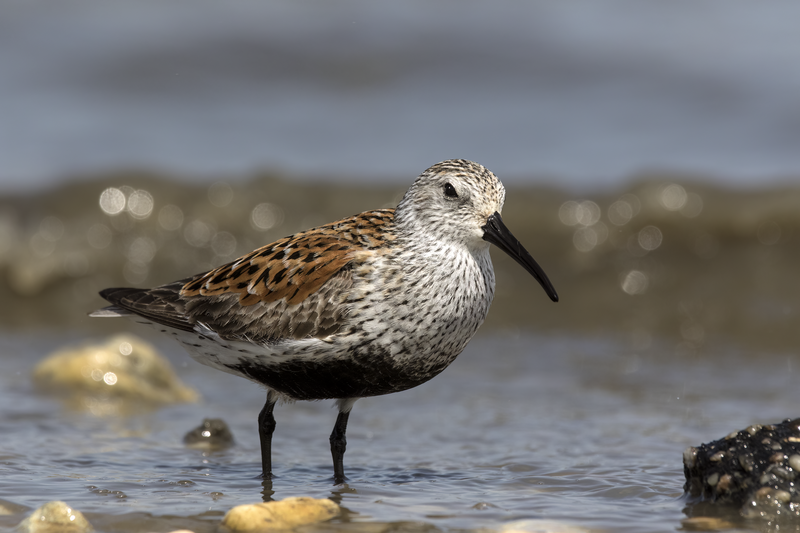
The dunlin is a small species of wader, previously classified separately from other species in the genus Erolia. The name ‘dunlin’ is an English dialect of the term ‘dunling’, first used in the early 16th century.
The origin of the word is from the word ‘dun’, meaning a dull brown color, combined with the suffix ‘-ling’, meaning something or someone who has the same quality. The dunlin is a small bird, about 6 to 8 inches long, with a characteristic brown back and white underparts.
Its forehead has a black patch, and its wings have white stripes. Its bill is short and slightly curved downwards. Dunlins are migratory birds and can be found in large flocks in coastal areas throughout the world.
They feed on insects, crustaceans, worms, and other small aquatic organisms. In the breeding season, they build nests in shallow depressions on the ground near water, and both parents help to raise their young.
| Kingdom | Animalia |
| Phylum | Chordata |
| Class | Aves |
| Order | Charadriiformes |
| Family | Scolopacidae |
| Genus | Calidris |
| Species | C. alpina |
8. Spotted Sandpiper
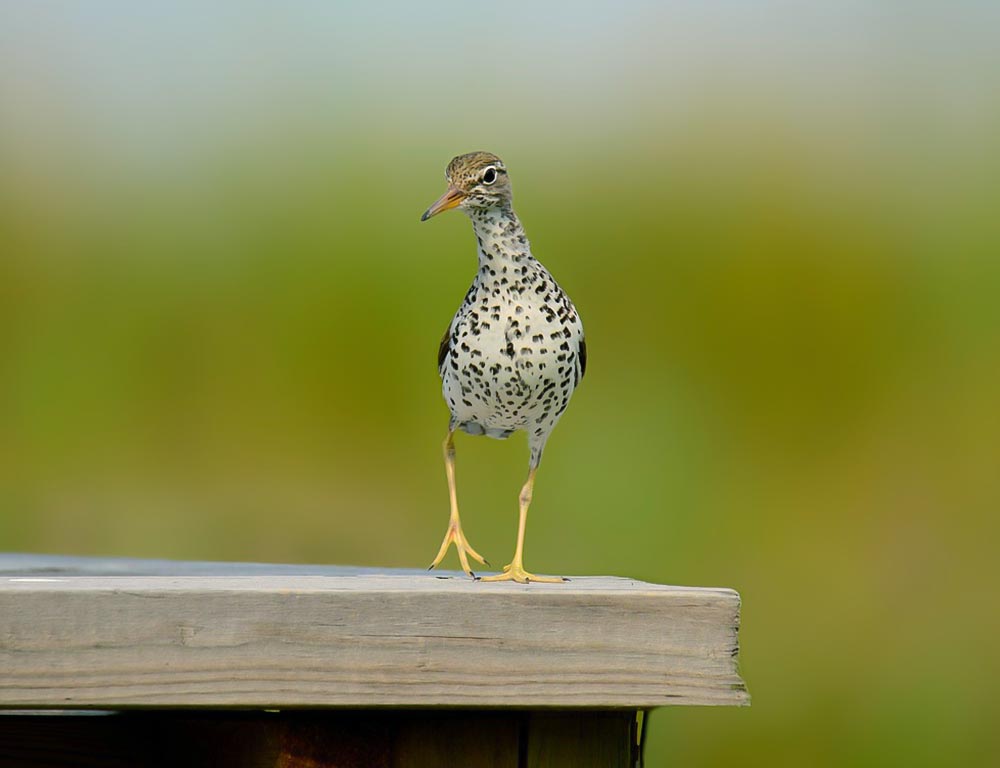
The spotted sandpiper is a small shorebird in the genus Actitis, along with its sister species, the common sandpiper. These two species are found in different geographical regions around the world, but occasionally, they may be found in the same area.
If this happens, the two species may hybridize, meaning they may interbreed and produce offspring of mixed heritage. This hybridization is possible because both species are closely related and can mate successfully.
The occurrence of hybridization suggests that the two species have similar genetic makeup. Hybridization may also be encouraged by the presence of stray birds that have settled in the same area as the breeders.
This is because additional mates increase the chances of finding a suitable mating partner.
| Kingdom | Animalia |
| Phylum | Chordata |
| Class | Aves |
| Order | Charadriiformes |
| Family | Scolopacidae |
| Genus | Actitis |
| Species | A. macularius |
9. Great Blue Heron
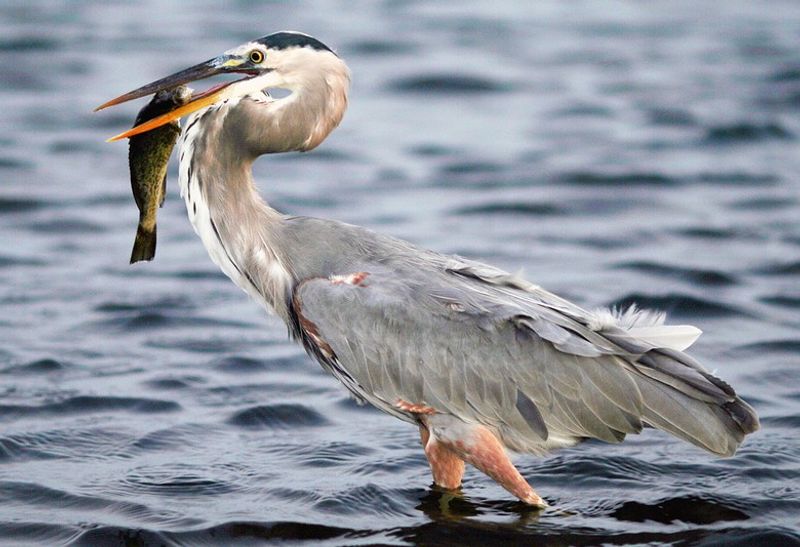
The great blue heron is a majestic bird that can be found in multiple areas around the world. It belongs to the heron family, Ardeidae, which is a large group of wading birds that inhabit wetland areas and areas near the shores of open water.
In North and Central America, the great blue heron is a common sight, as well as in far northwestern South America, the Caribbean, and the Galápagos Islands.
Its habitat is varied, allowing it to be found in various places, such as marshes, rivers, lakes, and estuaries. The great blue heron has a distinct appearance, with a long neck, a long bill, and long legs that allow it to wade in shallow water.
It is usually gray-blue and can reach a height of up to 4.5 feet. It feeds primarily on fish, frogs, and small aquatic animals, using its long bill to catch its prey. Additionally, it is an efficient flyer, using its broad wings to soar through the air.
The great blue heron is an impressive bird that can be found in a wide range of habitats around the world. Its unique features, such as its large wingspan and long bill, make it a captivating sight in the wild, and its wide range allows it to be seen by many people.
| Kingdom | Animalia |
| Phylum | Chordata |
| Class | Aves |
| Order | Pelecaniformes |
| Family | Ardeidae |
| Genus | Ardea |
| Species | A. herodias |
10. Common Guillemot
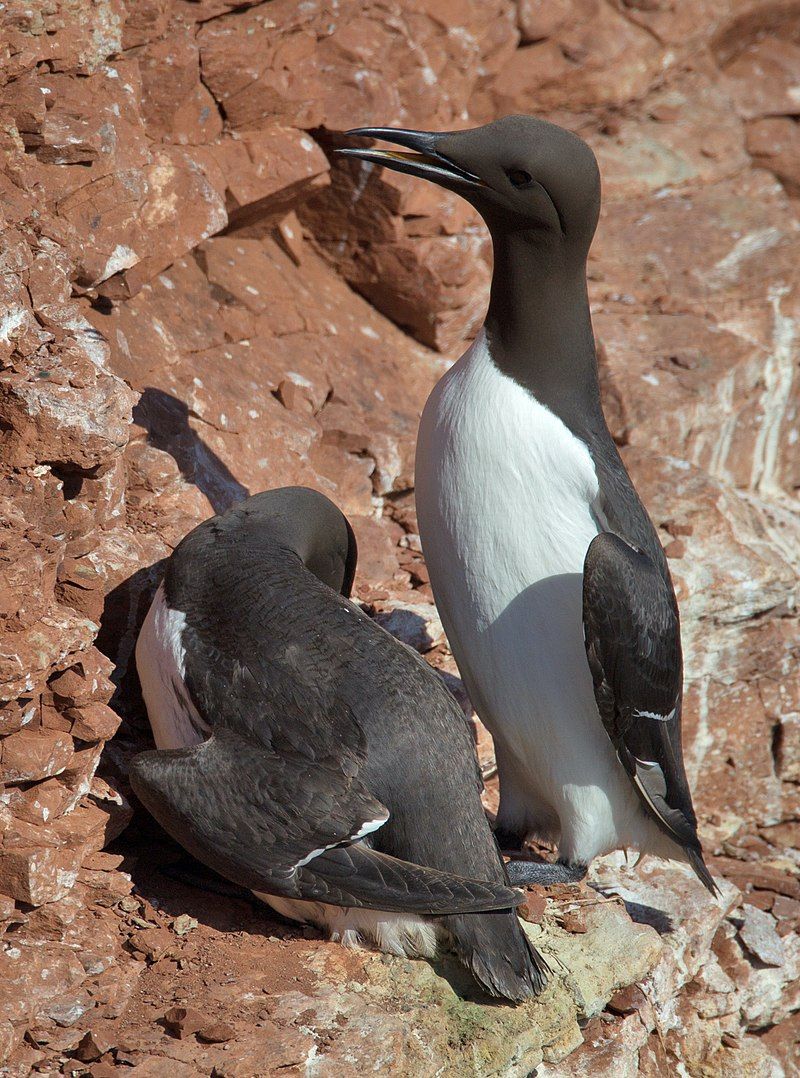
The common murre, or the common guillemot, is a large auk species found worldwide. It is distributed across the North Atlantic and North Pacific, inhabiting both low-Arctic and boreal waters.
This bird spends much of its life living in the sea, only coming to land to breed on rocky shorelines and islands. The common murre can be identified by its black feathers, white belly, and bright orange legs and feet.
This species has a length of 30-40 cm and a wingspan of up to 60 cm. It has a fairly large bill and a black spot on its ear cover. The common murre feeds mainly on small fish and crustaceans, diving to depths of up to 60 meters to find prey.
It breeds on rocky and often cliffs and islands, nesting in crevices and ledges. The female lays one egg, which is incubated for around 30 days.
The young fledge after 50-60 days but can remain with their parents for up to two years. The common murre is a species of least concern, and its population numbers are stable. It is protected in some areas due to its importance to local fisheries.
| Kingdom | Animalia |
| Phylum | Chordata |
| Class | Aves |
| Order | Charadriiformes |
| Family | Alcidae |
| Genus | Uria |
| Species | U. aalge |
11. Brown Pelican
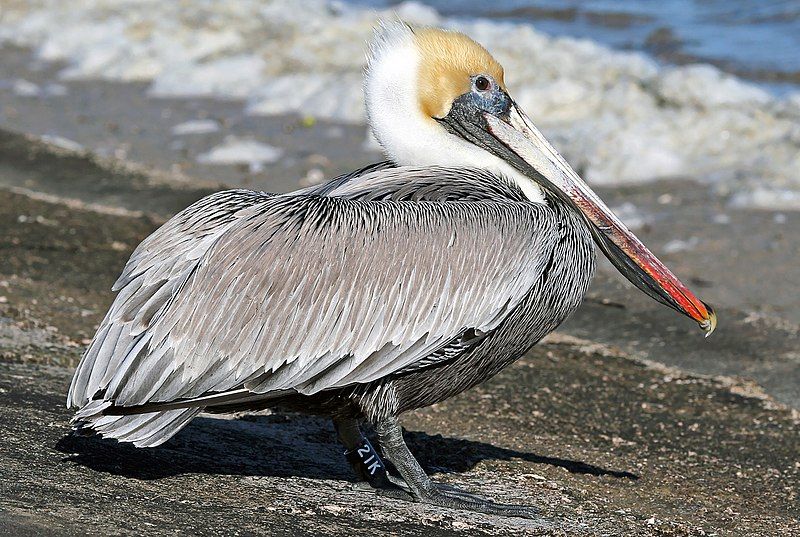
The brown pelican is a large bird belonging to the Pelecanidae family, comprised of several species of pelicans found throughout the Americas. Out of these species, the brown pelican is one of the two that feed by diving into the water.
This type of feeding is done by flying high up in the air and then using its large bill to scoop up fish from the water below. The brown pelican is a large bird with long wings and a wingspan reaching up to nine feet.
Its feathers are mostly brown, but it also has gray and white feathers. It has long, thin legs and a large bill with a pouch beneath it, which it uses to store food. The brown pelican is a strong swimmer who can dive up to 20 feet deep for its prey.
It can also fly at up to 40 mph speeds, enabling it to reach its destination quickly. The brown pelican is a fascinating species; its ability to dive into the water to feed is one of its most unique features.
| Kingdom | Animalia |
| Phylum | Chordata |
| Class | Aves |
| Order | Pelecaniformes |
| Family | Pelecanidae |
| Genus | Pelecanus |
| Species | P. occidentalis |
12. Herring Gull
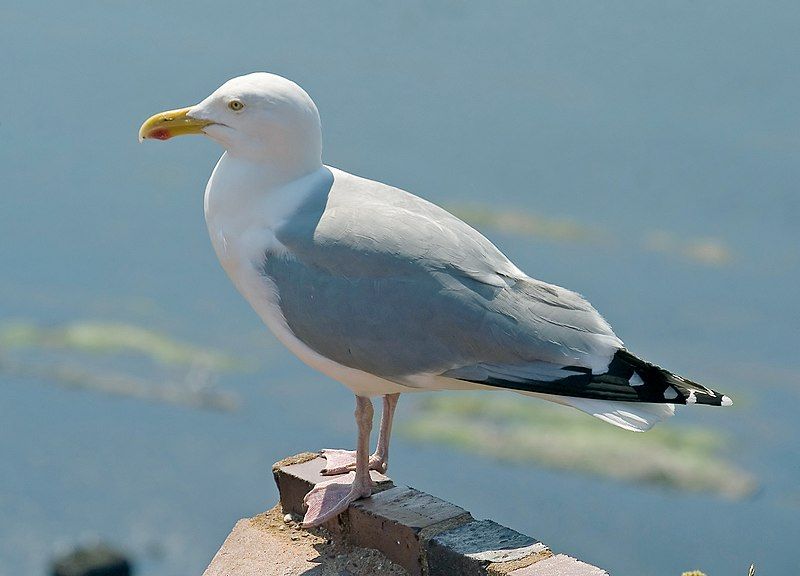
The European herring gull is a large bird, measuring up to 66 cm in length. It is a common species in the coastal regions of Western Europe and was historically even more abundant.
This species breeds across a wide range of northern and central Europe, including Scandinavia, the Baltic States, and the United Kingdom. It is a very adaptable species and can be found worldwide, from North and South America to Africa and Asia.
The European herring gull is an opportunistic feeder and will take whatever food is available, including fish, invertebrates, small mammals, eggs, and carrion. It is also a scavenger and will eat food scraps from people.
The European herring gull is also a social bird, often seen in large flocks. They are known to be quite vocal, and their calls are easily recognizable.
| Kingdom | Animalia |
| Phylum | Chordata |
| Class | Aves |
| Order | Charadriiformes |
| Family | Laridae |
| Genus | Larus |
| Species | L. argentatus |
13. Black Skimmer
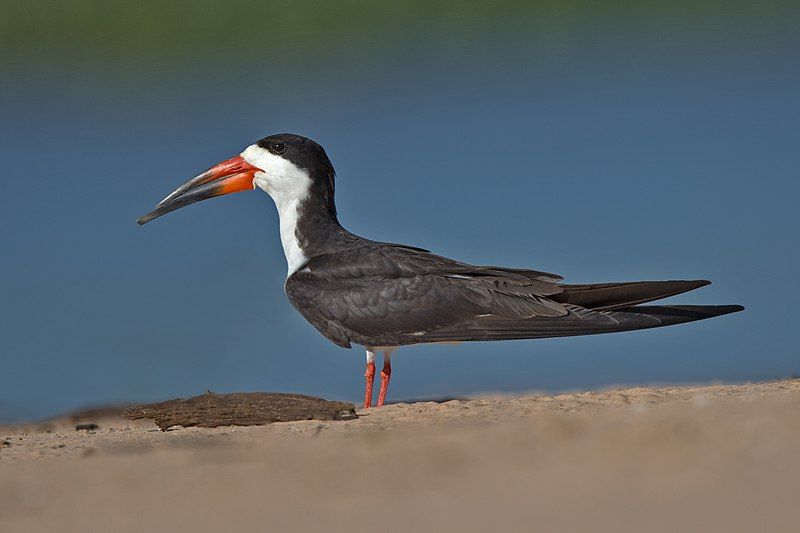
The black skimmer is a type of seabird that belongs to the skimmer genus Rynchops, which is part of the gull family Laridae. It is one of three similar bird species in this genus, and it breeds in North and South America.
The black skimmer is a tern-like bird with a small, narrow bill and a pointed tail. Its curved bill is adapted for its unique feeding behavior, skimming the water’s surface with its lower bill to scoop up small fish.
The black skimmer is a vocal bird with a wide range of calls and songs used to communicate. It is a monogamous species, and pairs form strong bonds lasting for several years. The black skimmer is a social species, often forming large colonies to breed.
During the breeding season, the birds can be seen flying in large flocks along the coasts of the Americas.
| Kingdom | Animalia |
| Phylum | Chordata |
| Class | Aves |
| Order | Charadriiformes |
| Family | Laridae |
| Genus | Rynchops |
| Species | R. niger |
14. Short-Billed Dowitcher
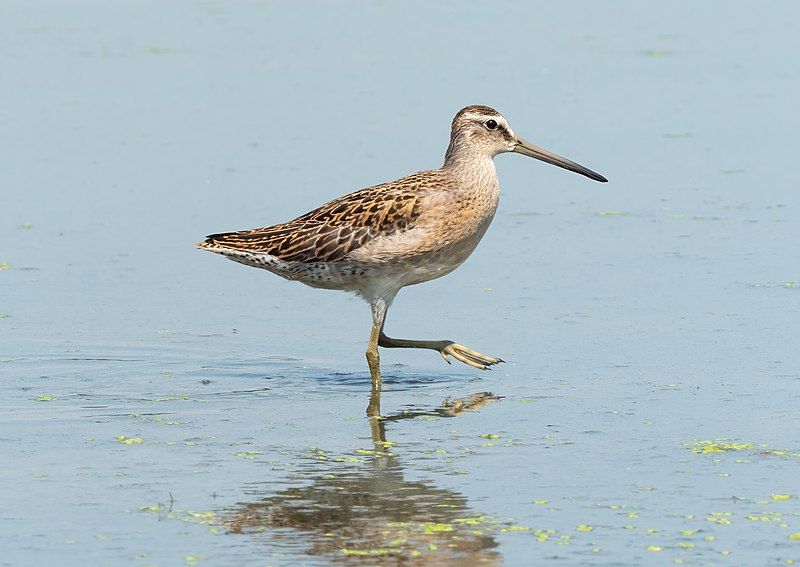
The short-billed dowitcher is a species of bird that belongs to the family Scolopacidae, which includes medium-sized, stocky shorebirds with long bills. It is native to North America, Central America, the Caribbean, and northern South America.
Its closest relative is the long-billed dowitcher, which is very similar in size, shape, and habitat preferences. The short-billed dowitcher is a migratory species, traveling long distances to reach its preferred wintering grounds.
It generally prefers shallow wetlands, estuaries, and mudflats, where it can feed on various aquatic insects, crustaceans, and other invertebrates. It is also known to eat small fish, seeds, and berries occasionally.
During the breeding season, they can be found in freshwater and brackish wetlands, nesting in shallow depressions on the ground. The short-billed dowitcher is a fairly common species, but its numbers have declined in recent years due to habitat loss and degradation.
Conservation efforts are in place to protect this species, such as protecting its breeding and wintering habitats.
| Kingdom | Animalia |
| Phylum | Chordata |
| Class | Aves |
| Order | Charadriiformes |
| Family | Scolopacidae |
| Genus | Limnodromus |
| Species | L. griseus |
15. Shorebirds
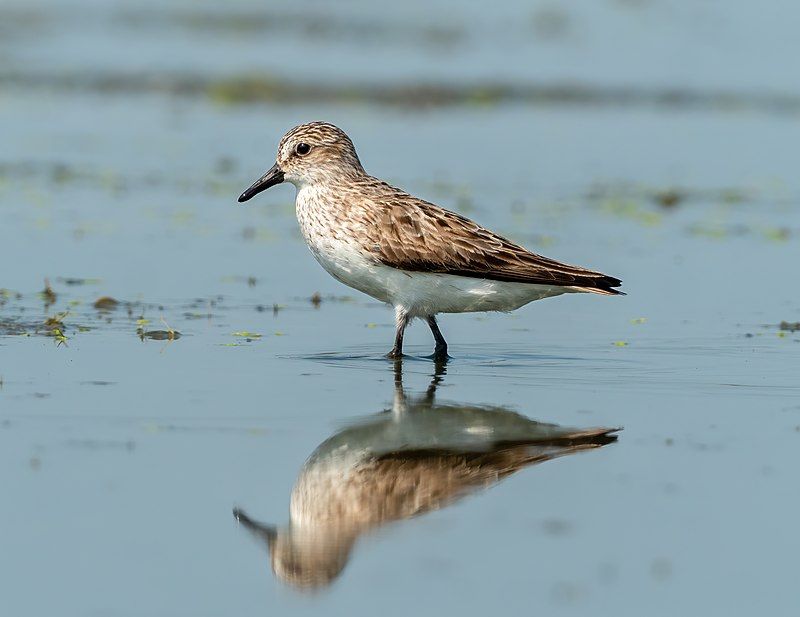
Waders, or shorebirds, are birds that belong to the Charadriiformes order. They are commonly found near shorelines and mudflats, where they search for food. These birds wade through the mud and sand, looking for small creatures like aquatic insects or crustaceans.
This behavior is known as foraging, which involves digging or crawling in the mud to find food. Waders are highly adapted for this type of behavior, with long, thin legs and webbed feet that allow them to move quickly and easily through shallow water.
Their long beaks can probe the muddy ground, and their sharp eyes can spot the small prey they are after. Not only are waders well-adapted to their environment, but they also provide a valuable service to the ecosystem.
By foraging in the mud, they help keep the water clean by consuming organic material and other pollutants. They also keep predator populations in check by eating insects and other invertebrates that might otherwise damage crops and other vegetation.
Waders are an important part of the environment, and their presence in shorelines and mudflats is a testament to the importance of preserving these habitats. Without their resources, these birds would be unable to survive.
| Kingdom | Animalia |
| Phylum | Chordata |
| Class | Aves |
| Clade | Gruimorphae |
| Order | Charadriiformes |
16. Common Tern
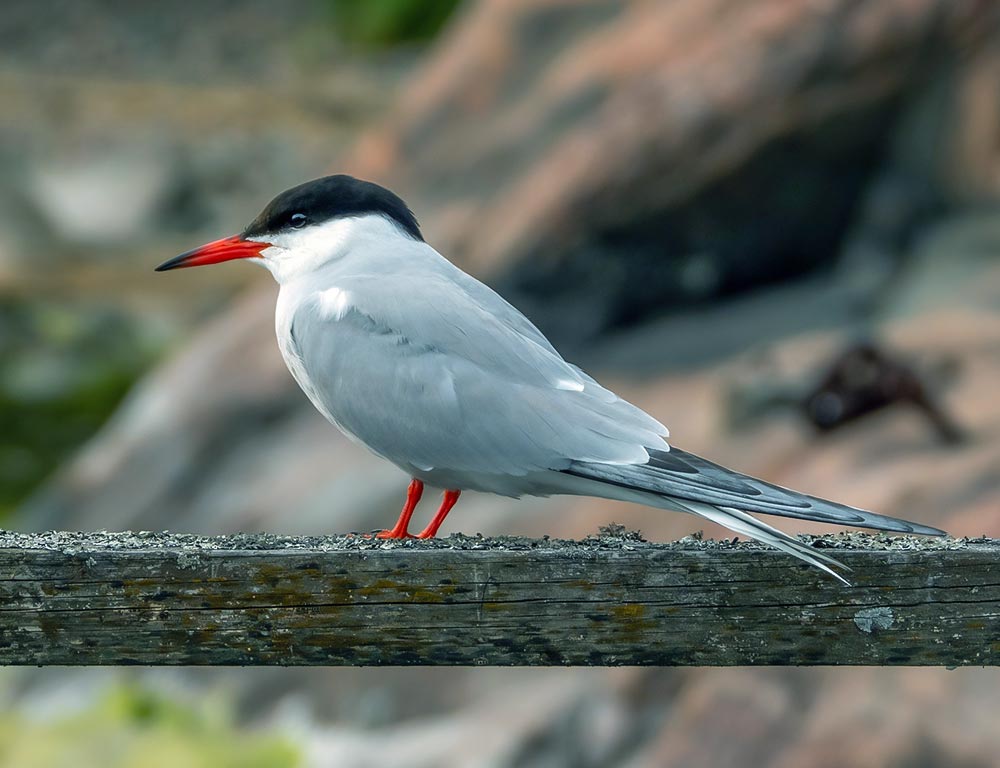
The common tern is a seabird species belonging to the family Laridae. It is commonly found in temperate and subarctic regions of Europe, Asia, and North America, making it a circumpolar species.
This species is highly migratory, meaning it will travel long distances to reach warmer climates during the winter season. In particular, it will migrate to coastal tropical and subtropical regions in order to survive the colder months.
Thus, This species can use the warmer climates to survive the winter and then migrate back to its native habitat when temperatures become more favorable.
This species’ ability to migrate long distances is an important factor in its survival and is a unique adaptation amongst seabirds.
| Kingdom | Animalia |
| Phylum | Chordata |
| Class | Aves |
| Order | Charadriiformes |
| Family | Laridae |
| Genus | Sterna |
| Species | S. hirundo |
17. Black Bellied Plover
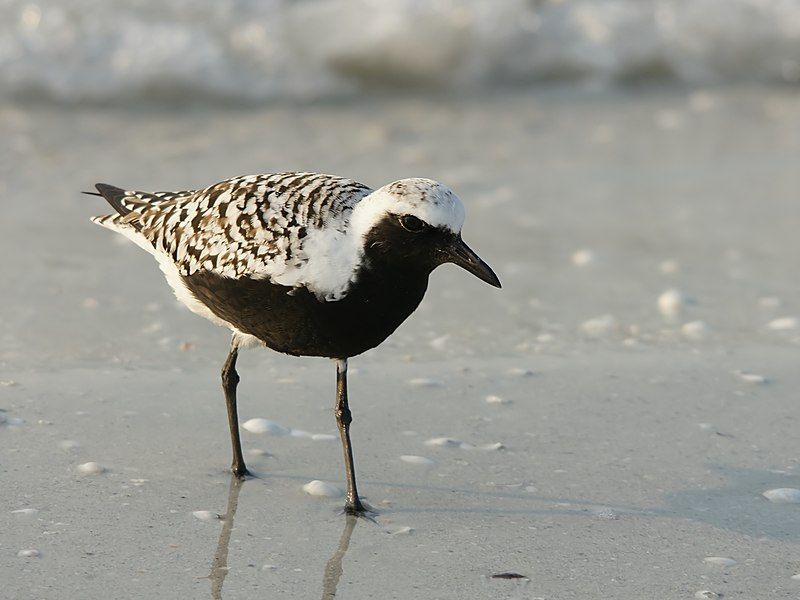
The Grey Plover, also known as the Black-bellied Plover in North America, is a species of large cosmopolitan shorebird. It is found in the Arctic region, breeding during the summer months.
The Grey Plover is a long-distance migrant, meaning that it will travel long distances between its breeding and wintering areas. During the winter, the Grey Plover can be found along the coasts of many countries, having a nearly worldwide coastal distribution.
This species is a vital part of its Arctic and coastal ecosystems when breeding and wintering. It feeds on insects, crustaceans, and mollusks and is an important food source for many predators.
| Kingdom | Animalia |
| Phylum | Chordata |
| Class | Aves |
| Order | Charadriiformes |
| Family | Charadriidae |
| Genus | Pluvialis |
| Species | P. squatarola |
18. American Avocet
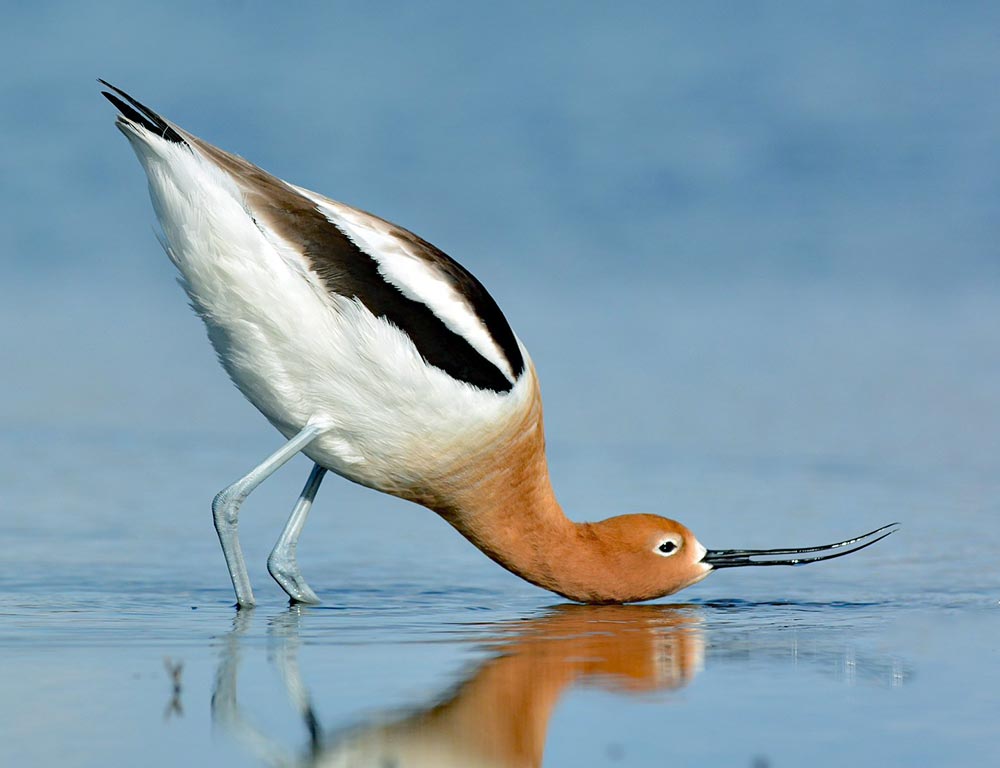
The American Avocet is a species of wading bird found in North America that belongs to the avocet and stilt family, Recurvirostridae.
It is a fairly large bird, measuring around 16-18 inches in length, with long legs, a slender neck, and a bill that is distinctive for its upturned shape.
The American avocet has a wide range across North America, including the Atlantic, Pacific, and Gulf of Mexico coasts. It can be found foraging in shallow water or mud flats, primarily during spring and summer.
Its diet consists of small aquatic creatures such as crustaceans and insects, which it obtains by sweeping its bill from side to side in the water. It has also been observed using its bill to probe into the mud for food.
The American Avocet is an important part of the ecosystem in its range, helping to maintain the balance of the aquatic food web by preying on small creatures. It is an attractive bird with its distinctive bill, elegant wading posture, and bright white and chestnut plumage.
It is a species of conservation concern in some parts of its range, so it is important to take steps to protect its habitat and ensure its continued survival.
| Kingdom | Animalia |
| Phylum | Chordata |
| Class | Aves |
| Order | Charadriiformes |
| Family | Recurvirostridae |
| Genus | Recurvirostra |
| Species | R. americana |
19. Double-Crested Cormorant
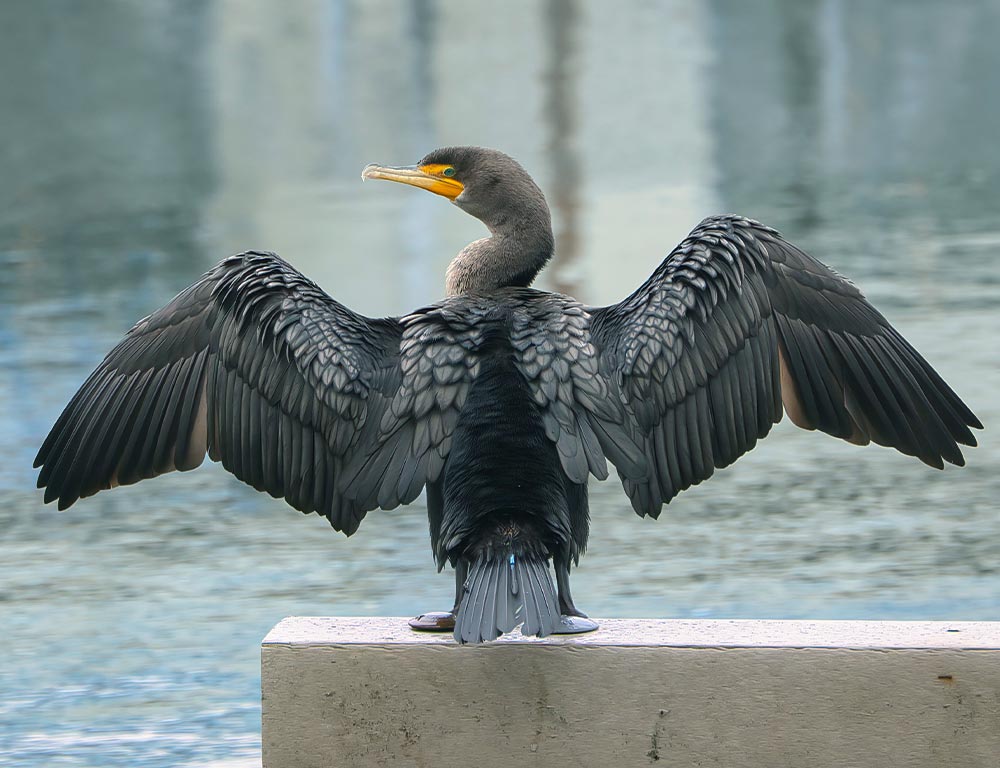
The Double-crested Cormorant is an aquatic bird from the cormorant family. It is found near bodies of water such as rivers, lakes, and coastal areas. The species is native to North America, from the Aleutian Islands in Alaska all the way down to Florida and Mexico.
This wide distribution makes the Double-crested Cormorant one of the most common birds in the region. The Double-crested Cormorant is a large bird with a wingspan of up to four feet. It has a long, hooked beak and a distinctive double crest of feathers on its head.
The bird’s feathers are black or dark gray in color, and the wings are often held in a V-shape.
The Double-crested Cormorant is a powerful swimmer and is able to dive deep into the water to catch its prey. The Double-crested Cormorant is an opportunistic feeder and will eat various prey.
Its diet typically consists of fish, crustaceans, and other aquatic creatures. The bird also eats amphibians, reptiles, and even small mammals such as mice and voles. The Double-crested Cormorant is a social species and is often seen in large flocks.
The birds breed during summer and typically lay three to five eggs in their nests. The young birds are born with a white downy coat and will grow their adult plumage in a few months.
The species is not considered to be threatened and is listed as a species of least concern on the IUCN Red List.
| Kingdom | Animalia |
| Phylum | Chordata |
| Class | Aves |
| Order | Suliformes |
| Family | Phalacrocoracidae |
| Genus | Nannopterum |
| Species | N. auritum |
20. Greater Yellowlegs
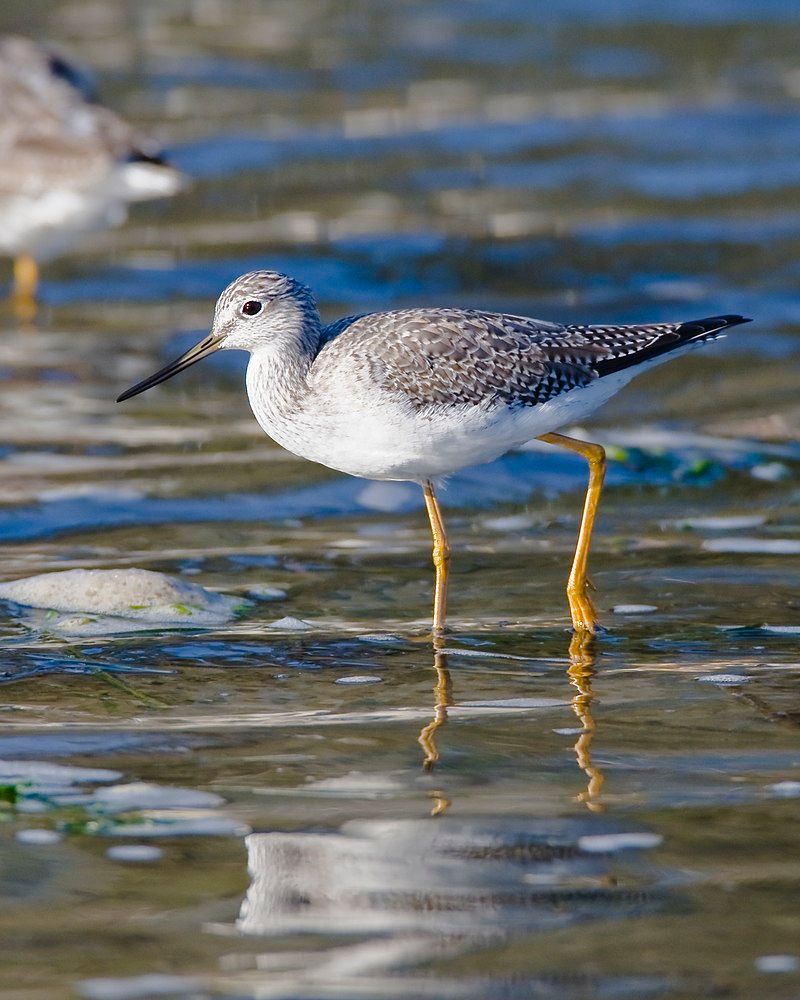
The greater yellowleg is a large shorebird belonging to the Scolopacidae family. It breeds in the central areas of Canada and southern Alaska. During the winter season, it migrates to the southern parts of North America, Central America, the West Indies, and South America.
The greater yellowlegs are considered to be long-distance migrants with a broad range of migration patterns. This bird mainly feeds on invertebrates, which it obtains from mudflats, wet meadows, and other wetland areas. It will also occasionally eat small fish and amphibians.
It has a long bill that is adapted to feeding in shallow water, and it is often seen walking around in the shallows, probing for food. The greater yellowlegs are sociable and can often be found in large flocks.
During the breeding season, they will form monogamous pairs and nest on the ground. The female will lay 3-4 eggs, which she will incubate for about 21-26 days.
The chicks will fledge at around 20-30 days old. The greater yellowlegs are an important species for shorebird conservation. It is considered to be of least concern by the IUCN due to its large population size and wide range.
However, it is still vulnerable to human activity, such as habitat destruction and pollution. Therefore, it is important to ensure that its habitat remains healthy.
| Kingdom | Animalia |
| Phylum | Chordata |
| Class | Aves |
| Order | Charadriiformes |
| Family | Scolopacidae |
| Genus | Tringa |
| Species | T. melanoleuca |
21. Pelicans
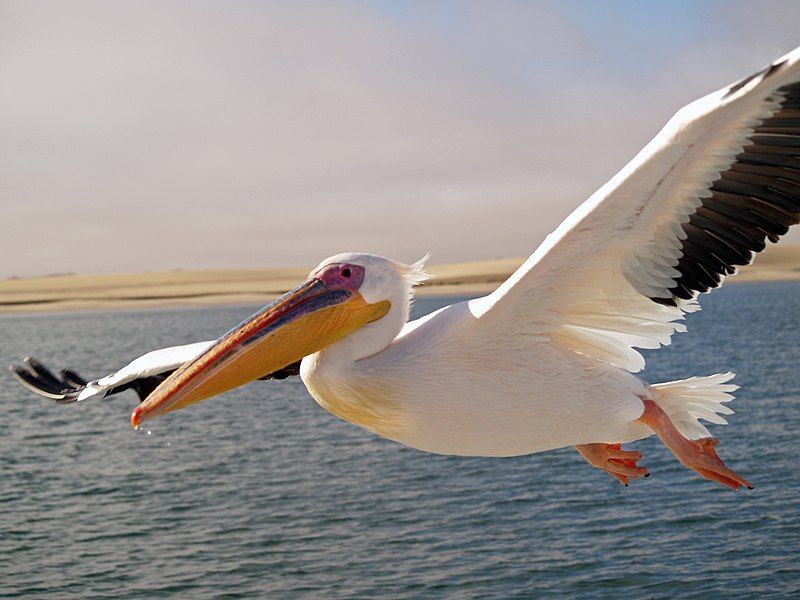
Pelicans are a large bird species that live in and around water and are part of the family Pelecanidae. These birds have a uniquely long beak and an even more impressive throat pouch that they use to scoop up food.
The throat pouch is designed to help them drain the water from their prey before they swallow it. While most pelicans have predominantly pale plumage, some of the species, such as the brown and Peruvian pelicans, feature a darker color.
The pelican’s beak is also very unique. It is shaped to help them easily scoop up their prey and hold it in their throat pouch. In addition to being used to catch prey, the beak also helps them to dive for food and maneuver around in the water.
Although they are considered water birds, pelicans can also be seen in various other habitats. Their ability to fly long distances and adaptability make them a species that can thrive in many different environments.
| Kingdom | Animalia |
| Phylum | Chordata |
| Class | Aves |
| Order | Pelecaniformes |
| Family | Pelecanidae |
| Genus | Pelecanus |
22. Gannet
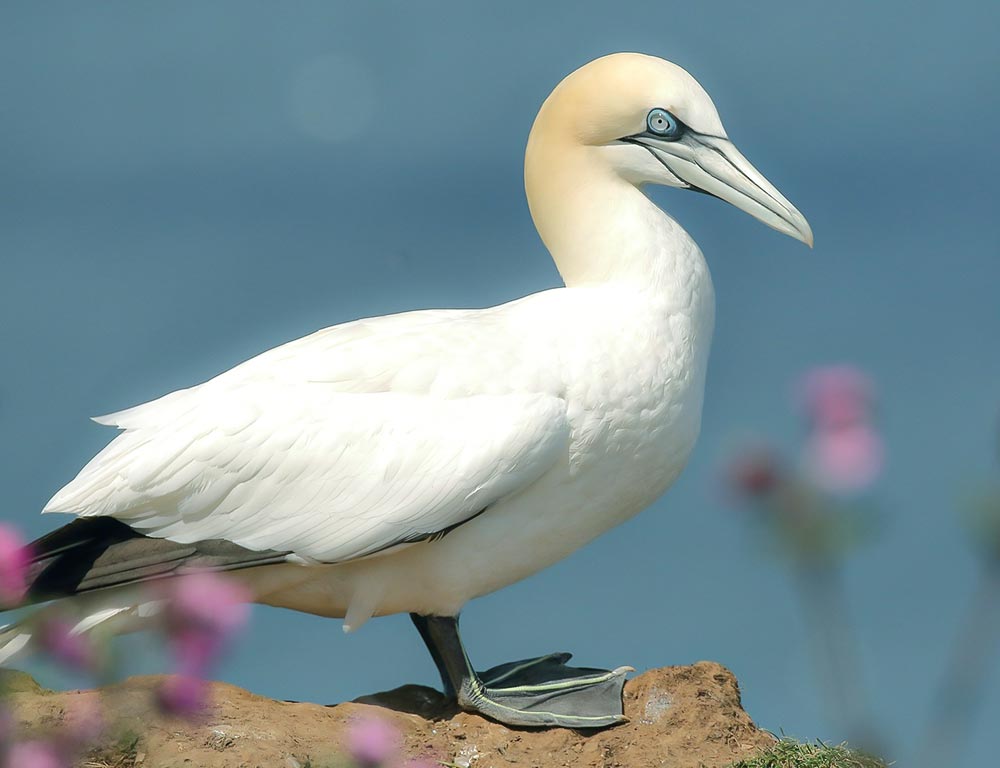
Gannets are a type of seabird that belongs to the genus Morus and the family Sulidae, which are closely related to boobies. They are large birds with white feathers and a yellowish head and are easily recognizable by their long black-tipped wings and long beaks.
Northern gannets are the biggest seabirds in the North Atlantic, boasting a wingspan of up to two meters in length. They are a sight to behold in the wild, as their wingspan allows them to soar gracefully through the sky.
Gannets are also impressive divers, plunging deep into the sea to catch their prey. Their diet consists mainly of fish, but they will also eat other seabirds and small marine mammals if they are available.
Gannets are highly social birds, often gathering to hunt and breed in large groups. They are a remarkable species and a vital part of the marine ecosystem.
| Kingdom | Animalia |
| Phylum | Chordata |
| Class | Aves |
| Order | Suliformes |
| Family | Sulidae |
| Genus | Morus |
23. Ring-Billed Gull
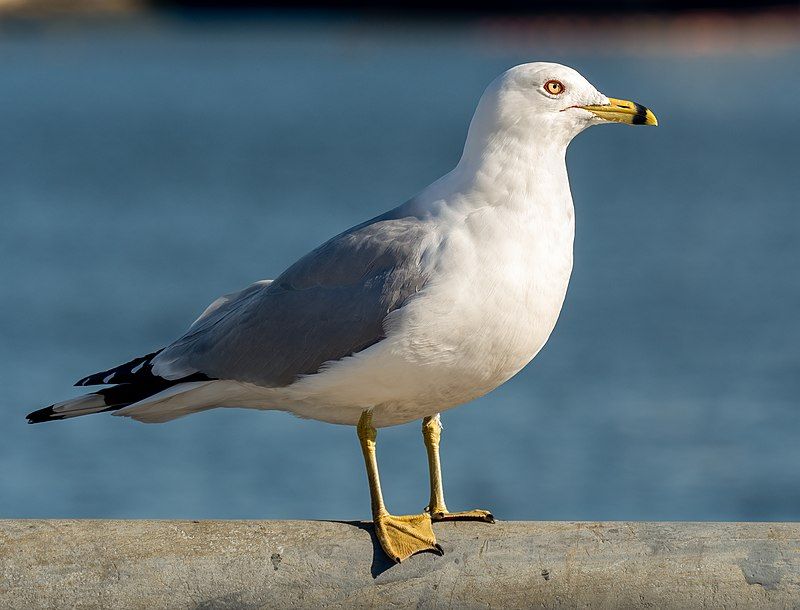
The ring-billed gull is a species of gull belonging to the medium-sized category. It is scientifically known as Larus delawarensis, with the genus name coming from Latin and referring to a large seabird, while the specific delawarensis refers to the Delaware River.
Ring-billed gulls are commonly seen in North America, especially in large inland lakes, rivers, and coastal areas. The ring-billed gull’s scientific name can be divided into two distinct parts.
The genus name of Larus is Latin, which is believed to have originated from the Latin word for a large seabird. The specific delawarensis is a reference to the Delaware River, which is a large river located in the eastern United States.
The ring-billed gull is a fairly common species in North America and can be found in various habitats, including coastal areas, large inland lakes, and rivers. It is a migratory species that can be seen in large flocks when they travel south during winter.
The ring-billed gull is a medium-sized gull with a distinctive ring around its bill.
The adult has a gray back and wings with white under-parts and a black bill with a yellow ring around it. Overall, the ring-billed gull is a common species of gull that can be found in various habitats throughout North America.
Its scientific name, Larus delawarensis, reveals its origins and habitat preferences, with the genus name coming from Latin and referring to a large seabird, while the specific delawarensis refers to the Delaware River.
The ring-billed gull has a distinctively marked bill with a yellow ring and is a medium-sized gull.
| Kingdom | Animalia |
| Phylum | Chordata |
| Class | Aves |
| Order | Charadriiformes |
| Family | Laridae |
| Genus | Larus |
| Species | L. delawarensis |
24. Laughing Gull
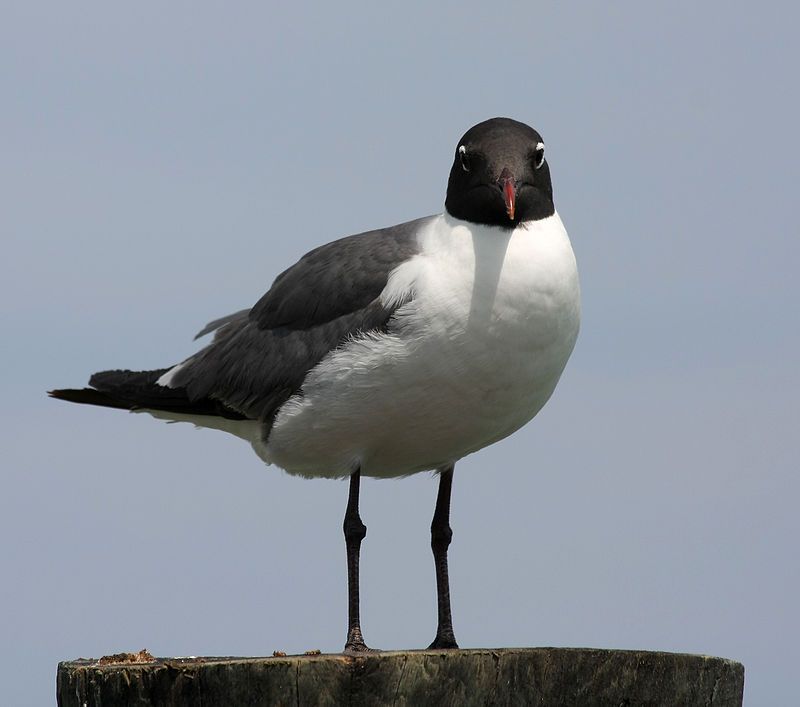
The Laughing Gull is a bird species found in North and South America. It gets its name from its distinctive call, which sounds like a laugh. It is an omnivore and scavenger, meaning it eats various foods, both plant and animal.
It breeds in large colonies, primarily along the Atlantic coast of North America, the Caribbean, and northern South America. The Laughing Gull has two subspecies: L. a. and L. b.
| Kingdom | Animalia |
| Phylum | Chordata |
| Class | Aves |
| Order | Charadriiformes |
| Family | Laridae |
| Genus | Leucophaeus |
| Species | L. atricilla |
Conclusion
Birds in Seaside are a remarkable part of the local environment and provide an important source of beauty and diversity for the area.
They are an integral part of the local ecosystem, as they are important pollinators and help to control insect populations. The variety of bird species in Seaside also provides unique opportunities for birdwatching and bird photography.
Protecting and conserving the local birds and their habitats is important to ensure their continued presence in the area.